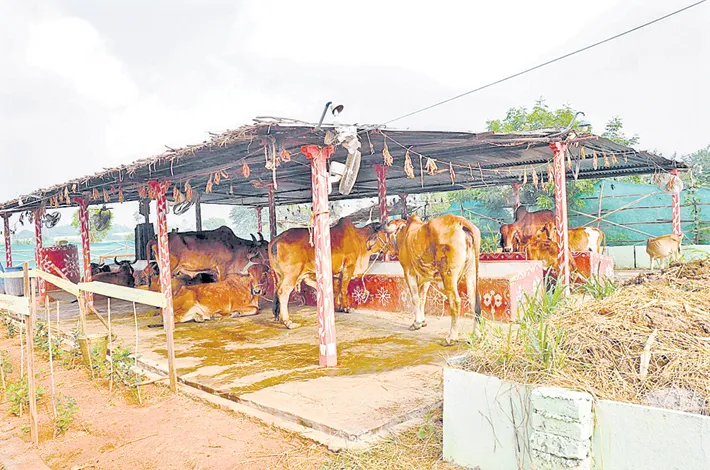Temple Goshalas under Reforms ahead
13-08-2025 12:00:00 AM

■ 69 temple Goshalas in 33 districts house 3,009 cattle on about 200 acres.
■ Endowments Dept survey finds crowded sheds, little land, and unhealthy cattle in private temple trusts.
■ Vemulawada (60 acres) and Yadagirigutta (40 acres) sites identified for flagship facilities
■ Temples with land banks in districts may set up Goshalas on at least 25 acres for free grazing and better cattle health.
MAHESH AVADHUTHA I hyderabad
In a state where cows hold deep cultural and spiritual significance, a new survey by the Telangana Endowments Department has exposed the stark reality of Goshalas—cattle shelters attached to temples—revealing an uneven and often inadequate system. From sprawling sanctuaries to cramped, underfunded sheds, the condition of these shelters has prompted the state government to embark on an ambitious reform drive.
According to official records, there are 69 Goshalas in temples across 33 districts, together housing 3,009 cattle on over 194 acres of land. The distribution, however, is highly skewed. Rajanna Sircilla dominates the list with a single Goshala under the Vemulawada temple caring for 1,282 oxen on six acres, while Yadadri Bhongir’s Sri Lakshmi Narasimha Swamy temple manages 206 cattle on over 12 acres. In sharp contrast, Kamareddy’s four Goshalas—mostly run by private trusts—house 333 cattle in just 19 guntas, not even half an acre. Several districts report facilities with fewer than 10 animals, including cattle maintained privately near small temples that lack the funds to support them, resulting in poor health and even deaths.
The data also reveals that a significant number of districts have Goshalas with fewer than 50 cattle, pointing to highly fragmented and underutilised facilities. Hyderabad has 8 Goshalas with just 161 cattle, Secunderabad 9 with 65 cattle, Rangareddy 8 with 98 cattle, and Medchal Malkajgiri 4 with 31 cattle. Sangareddy has 30, Nalgonda 11, Suryapet 11, Mahabubnagar 10, Narayanpet only 2, and Khammam 25. Similarly, Adilabad has 40 cattle, Karimnagar 15, Siddipet 41, Nizamabad 34, Hanumakonda 14, Mahabubabad 19, and J.S. Bhupalpally just 2. These small numbers—often scattered in multiple tiny Goshalas—highlight the lack of consolidation and efficient use of resources.
Recognising the urgency, Chief Minister A. Revanth Reddy has prioritised the Goshala issue, with plans to draft a new policy for streamlining operations, fixing clear rules, and ensuring sustainable upkeep. The government is also moving to establish five Model Goshalas across the state, each on nearly 50 acres, to provide open grazing lands and natural vegetation—offering cattle a healthier life than the confinement of small concrete sheds.
Land identification is already in progress for two major facilities: nearly 60 acres in Vemulawada and 40 to 50 acres in Yadagirigutta. District collectors have submitted proposals, and final approvals are awaited. These will act as flagship centres, setting welfare benchmarks for other Goshalas.
At the policy level, the Cabinet has approved a three-member committee headed by Chief Secretary Sabyasachi Ghosh, with Shailaja Ramaiyar (Endowments) and Raghunandan Rao (Agriculture), to oversee modernisation. The Animal Husbandry Department has proposed advanced designs for facilities at Yenkepally, Veterinary University, Vemulawada, and Yadagirigutta. Telangana, overall, has 306 registered Goshalas housing around 54,000 cattle, including those under Endowments.
The CM has underscored the spiritual and cultural importance of cattle, directing the committee to adopt best practices from other states. The ultimate goal: transform Goshalas from overcrowded, resource-starved enclosures into true sanctuaries—places where every cow, bull, and calf can live with dignity, space, and care.








